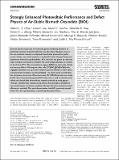| dc.contributor.author | Lee, Lana C. | |
| dc.contributor.author | Huq, Tahmida N. | |
| dc.contributor.author | Zhang, Kelvin H. L. | |
| dc.contributor.author | Kursumović, Ahmed | |
| dc.contributor.author | Stevanović, Vladan | |
| dc.contributor.author | MacManus-Driscoll, Judith L. | |
| dc.contributor.author | Hoye, Robert L. Z. | |
| dc.contributor.author | Kurchin, Rachel Chava | |
| dc.contributor.author | Sponseller, Melany Christine | |
| dc.contributor.author | Nienhaus, Lea | |
| dc.contributor.author | Brandt, Riley E | |
| dc.contributor.author | Jean, Joel | |
| dc.contributor.author | Polizzotti, James Alexander | |
| dc.contributor.author | Bawendi, Moungi G | |
| dc.contributor.author | Bulovic, Vladimir | |
| dc.contributor.author | Buonassisi, Anthony | |
| dc.date.accessioned | 2018-01-08T16:29:37Z | |
| dc.date.available | 2018-01-08T16:29:37Z | |
| dc.date.issued | 2017-09 | |
| dc.date.submitted | 2017-05 | |
| dc.identifier.issn | 0935-9648 | |
| dc.identifier.issn | 1521-4095 | |
| dc.identifier.uri | http://hdl.handle.net/1721.1/113014 | |
| dc.description.abstract | Bismuth-based compounds have recently gained increasing attention as potentially nontoxic and defect-tolerant solar absorbers. However, many of the new materials recently investigated show limited photovoltaic performance. Herein, one such compound is explored in detail through theory and experiment: bismuth oxyiodide (BiOI). BiOI thin films are grown by chemical vapor transport and found to maintain the same tetragonal phase in ambient air for at least 197 d. The computations suggest BiOI to be tolerant to antisite and vacancy defects. All-inorganic solar cells (ITO|NiO x |BiOI|ZnO|Al) with negligible hysteresis and up to 80% external quantum efficiency under select monochromatic excitation are demonstrated. The short-circuit current densities and power conversion efficiencies under AM 1.5G illumination are nearly double those of previously reported BiOI solar cells, as well as other bismuth halide and chalcohalide photovoltaics recently explored by many groups. Through a detailed loss analysis using optical characterization, photoemission spectroscopy, and device modeling, direction for future improvements in efficiency is provided. This work demonstrates that BiOI, previously considered to be a poor photocatalyst, is promising for photovoltaics. | en_US |
| dc.description.sponsorship | National Science Foundation (U.S.) (Grant CBET-1605495) | en_US |
| dc.description.sponsorship | United States. Department of Energy. Office of Basic Energy Sciences (Grant DE-SC0001088) | en_US |
| dc.description.sponsorship | National Science Foundation (U.S.) (Grant DMF-08019762) | en_US |
| dc.publisher | Wiley Blackwell | en_US |
| dc.relation.isversionof | http://dx.doi.org/10.1002/ADMA.201702176 | en_US |
| dc.rights | Creative Commons Attribution 4.0 International License | en_US |
| dc.rights.uri | http://creativecommons.org/licenses/by/4.0/ | en_US |
| dc.source | Wiley | en_US |
| dc.title | Strongly Enhanced Photovoltaic Performance and Defect Physics of Air-Stable Bismuth Oxyiodide (BiOI) | en_US |
| dc.type | Article | en_US |
| dc.identifier.citation | Hoye, Robert L. Z. et al. “Strongly Enhanced Photovoltaic Performance and Defect Physics of Air-Stable Bismuth Oxyiodide (BiOI).” Advanced Materials 29, 36 (July 2017): 1702176 © 2017 The Authors | en_US |
| dc.contributor.department | Massachusetts Institute of Technology. Department of Electrical Engineering and Computer Science | en_US |
| dc.contributor.department | Massachusetts Institute of Technology. Department of Materials Science and Engineering | en_US |
| dc.contributor.department | Massachusetts Institute of Technology. Department of Mechanical Engineering | en_US |
| dc.contributor.mitauthor | Hoye, Robert L. Z. | |
| dc.contributor.mitauthor | Kurchin, Rachel Chava | |
| dc.contributor.mitauthor | Sponseller, Melany Christine | |
| dc.contributor.mitauthor | Nienhaus, Lea | |
| dc.contributor.mitauthor | Brandt, Riley E | |
| dc.contributor.mitauthor | Jean, Joel | |
| dc.contributor.mitauthor | Polizzotti, James Alexander | |
| dc.contributor.mitauthor | Bawendi, Moungi G | |
| dc.contributor.mitauthor | Bulovic, Vladimir | |
| dc.contributor.mitauthor | Buonassisi, Anthony | |
| dc.relation.journal | Advanced Materials | en_US |
| dc.eprint.version | Final published version | en_US |
| dc.type.uri | http://purl.org/eprint/type/JournalArticle | en_US |
| eprint.status | http://purl.org/eprint/status/PeerReviewed | en_US |
| dc.date.updated | 2018-01-05T20:14:21Z | |
| dspace.orderedauthors | Hoye, Robert L. Z.; Lee, Lana C.; Kurchin, Rachel C.; Huq, Tahmida N.; Zhang, Kelvin H. L.; Sponseller, Melany; Nienhaus, Lea; Brandt, Riley E.; Jean, Joel; Polizzotti, James Alexander; Kursumović, Ahmed; Bawendi, Moungi G.; Bulović, Vladimir; Stevanović, Vladan; Buonassisi, Tonio; MacManus-Driscoll, Judith L. | en_US |
| dspace.embargo.terms | N | en_US |
| dc.identifier.orcid | https://orcid.org/0000-0002-7675-0065 | |
| dc.identifier.orcid | https://orcid.org/0000-0002-2147-4809 | |
| dc.identifier.orcid | https://orcid.org/0000-0002-4396-8818 | |
| dc.identifier.orcid | https://orcid.org/0000-0003-2785-552X | |
| dc.identifier.orcid | https://orcid.org/0000-0002-7758-1742 | |
| dc.identifier.orcid | https://orcid.org/0000-0002-8723-8024 | |
| dc.identifier.orcid | https://orcid.org/0000-0003-2220-4365 | |
| dc.identifier.orcid | https://orcid.org/0000-0002-0960-2580 | |
| dc.identifier.orcid | https://orcid.org/0000-0001-8345-4937 | |
| mit.license | PUBLISHER_CC | en_US |
